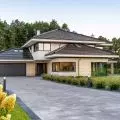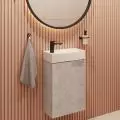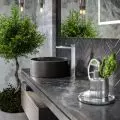Referring to Lemko farms, architects from the 9780 Architekci office created a studio in the Low Beskid. The building, located in one of the wildest regions of Poland, is made with respect for the surrounding landscape and environment.
The object refers to traditional Lemko architecture
Photo: Bartosz Kutniowski © 9780 Architekci
Dobrawa Bies: What was the main inspiration for the project, what is the shape of the block derived from?
Bartłomiej Homiński: The area where we designed the studio is located in the Low Beskids. The farms of the Lemkos - the Ruthenian population of that area - were in the form of chyżs, or wooden, oblong, single-building homesteads. The residential and farm parts, separated by the so-called "pitch" or outer farm hallway, were covered with a single gabled roof. This spatial arrangement, not so well known and disappearing from the landscape, was our main inspiration while working on the project.
The residential and farm parts, separated by the so-called "playground"
Photo: Bartosz Kutniowski © 9780 Architects
Dobrawa Bies: What was your priority in this project?
Bartlomiej Hominski: The site that the investor gave us was very vast, and the difference in height within it was several tens of meters. We resisted the temptation to place the building at the highest point of the plot, with views of the distant landscape. We wanted a sense of security and a connection to the landscape, but not to dominate it. The expression of these aspirations is the building's location at the lower part of the plot and the contemporary "pitch", which is a covered but open-sided outdoor room - something intermediate between being inside and outside. The deliberate closing of the view from here and looking up rather than down the meadow cuts out a familiar and safe piece of the world from the larger whole.
The building's construction is timber-frame
Photo: Bartosz Kutniowski © 9780 Architects
Dobrawa Bies: What were the expectations of the investors?
Bartłomiej Homiński: In working on this project, we were given more freedom on the part of the investors than is usually the case. Starting from the very choice of the building's location on the plot, through spatial, functional and material solutions. The investor's expectation, on the other hand, due to its location in one of the wildest regions of Poland, was to limit the building's impact on the environment. The reference in form to traditional Lemko construction, which I mentioned earlier, is only one aspect. Another is the use of renewable but durable, low-maintenance materialsfor construction. The structure of the building is timber-framed, the thermal insulation is wood wool, and the facade is made of untreated larch planks. All these materials bind carbon dioxide from the environment. The titanium-zinc sheet roof has the lowest carbon footprint of the available roof sheets. The pedestal and floors are made of Cergow sandstone from a deposit in nearby Komancza, and the details are made of galvanized steel. Over time, these materials will change their appearance: the planks will develop a silvery-gray patina and the roof will stain, but the way they age is part of a strategy to tread lightly, to minimize the footprint we leave behind.
Closing all shutters reduces the building to an openingless mass
Photo: Bartosz Kutniowski © 9780 Architects
Dobrawa Bies: What posed the greatest design difficulties, and what are you most satisfied with?
Bartłomiej Homiński: Due to the small number of transverse walls and the lack of a ceiling, the challenge was to ensure the rigidity of the structure in the central part of the building. This was achieved by having three cross-bracing structures located at the tie beam level and working in both compression and tension. The dimensional coordination of the design, combining prefabricated wall elements with a wood façade made on site, was also quite a challenge. It was designed in such a way as to reduce the building to an openingless mass, in which the position of windows and doors can hardly be indicated, once all the shutters are closed. Design discipline and the contractor's great understanding of the key features of this project led to a satisfying result.


















































